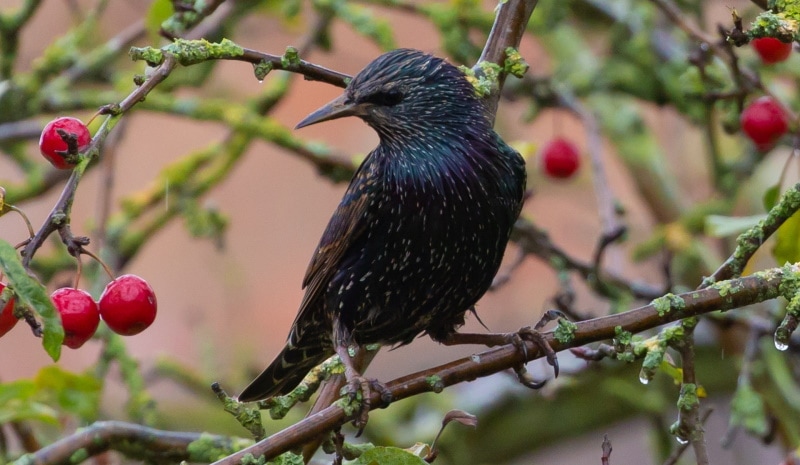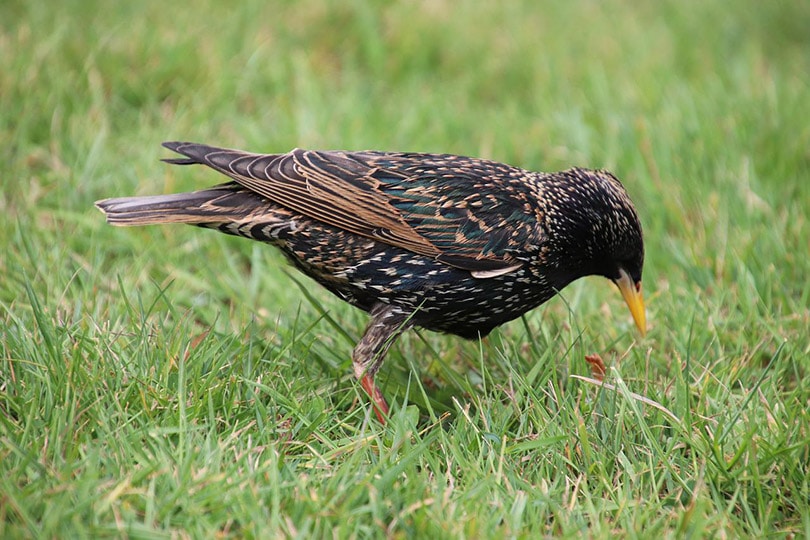Do Starlings Migrate? What Do They Do in the Winter?
Last Updated on

With shiny black feathers and pointed beaks, the starling birds are one of the prevalent social visitors worldwide. Whether you live in Asia, Africa, Europe, or North America, you may have seen starlings or heard their murmurings. Starlings are considered resident birds in the UK, but some also migrate. The population of Starlings in the UK increases every winter as hundreds migrate from Eastern Europe to the Northern and Western regions, including London, Canada, etc.
During the end of September and October in Europe, harsh, cold, and dry weather forces starlings to travel to the west. This enables them to live, breed, and feed in suitable conditions.
This article will explore the migratory behavior of starlings in the winter. In short, some starlings migrate, while others don’t. Let’s explore why!

Brief Overview of Starlings
Starling has a pointy beak, short tail, and triangular wings. Unlike other blackbirds, starlings are smaller in size. Their wings appear coal black from a distance but may look shiny with shades of purple, brown, and green from up close.
Starlings are among the most diverse and expansively distributed birds across the world. With 123 species and 35 genera, they have populations in Europe, Asia, and Africa.
These birds can extend their range to Mongolia, India, and the Pacific Ocean, including Melanesia, Polynesia, and Micronesia. They are highly adapted to their habitat, but such starlings exist in limited numbers.
Starlings are famous for their murmuration among birdwatchers. If you’re new to the term “starlings murmuration,” it is when starlings gather in a flock at the time of sunset to travel to their communal nesting site.
Murmuration often happens when the starlings migrate to a new place. The purpose behind these murmuration sounds is to protect the flock in the latest migration area.

What Do Starlings Do in the Winter?
Most starlings are residents in the UK and use gardens as their home shelter. However, some species, such as the Common or European starlings, are migratory.
Starlings migrate once a year from areas of low resources to areas of abundant resources. The two primary reasons for the starlings to migrate are nesting location and food availability.
If all the starlings stay in the same habitat all year-round, the competition for nesting and food becomes fierce and violent. Unfortunately, many birds become undernourished, leading to unsuccessful breeding.
As the food sources revive in the Northern areas during spring, thousands of starlings migrate to the UK before winter.
The practice of migration is not limited to neotropical starlings but also short-range migratory starlings that migrate only a small distance to pursue seasonal survival.

When Do Starlings Migrate?
The most common time for starlings to migrate is the end of summer and the beginning of the winter. The starling murmuration starts around October.
The number of starlings in the UK seems to increase as many birds migrate rapidly from the colder regions of Europe. However, most starlings return to their home in February. It is unclear as to why only a limited breed of starlings migrates.
Where Do Starlings Migrate?
The Starlings begin to migrate from Northern Europe to the UK, Southern Canada, and the Middle East to spend the winter during the month of October and November. You can notice flocks of starlings on the Each Coast of England during October and November. Most of these migratory starlings have flown from the North Sea from Belgium after covering the cold region across Northern Europe.
During the end of summer, the Common and European starlings mostly migrate from Northern Europe towards the UK and Central Europe, including the Middle East, Mediterranean, and North Africa. Common and European starlings in the US and Canada migrate similarly. However, they head towards the south in winter, not always very far.
Other species of starlings are often distributed across the south that don’t migrate at all. Only the species of starlings living in and across the Northernmost area migrate in the winter. Most starlings breed successfully when away from the North, especially during winter. The leading force behind the starlings’ migration is roosting, breeding, and food access. They survive the winter in flocks.

Is Migration Necessary for the Starlings?
Starlings have behavioral adaptations that help them survive and thrive in difficult times. Food resources and nesting location are the common reasons behind starling migration. Migration is a behavioral adaptation that improves the chances of survival.
Starlings can easily survive in the cold, harsh weather. However, the main reason to migrate is to have plenty of food. Wind, temperature, and precipitation are the common factors that impact the food resources, which is why starlings’ migration is seasonal.
Migrating from one place to another improves survival chances and leads to successful breeding.

Conclusion
Starlings are one of the widespread birds in several parts of the globe, including Asia, Europe, Africa, and North America. They are resident birds in the UK that don’t prefer migration. However, a large number of starlings do migrate in the winter.
Migration is an excellent survival process for starlings. It’s a natural adaptive process where starlings cover thousands of kilometers to find a suitable and safe ecological habitat for their survival, breeding, and feeding.
Whenever the environment at the breeding locations becomes unfavorable, migratory starlings fly to areas where the ecological condition is better.
Featured Image Credit: Kev, Pixabay
About the Author Jeff Weishaupt
Jeff is a tech professional by day, writer, and amateur photographer by night. He's had the privilege of leading software teams for startups to the Fortune 100 over the past two decades. He currently works in the data privacy space. Jeff's amateur photography interests started in 2008 when he got his first DSLR camera, the Canon Rebel. Since then, he's taken tens of thousands of photos. His favorite handheld camera these days is his Google Pixel 6 XL. He loves taking photos of nature and his kids. In 2016, he bought his first drone, the Mavic Pro. Taking photos from the air is an amazing perspective, and he loves to take his drone while traveling.
Related Articles:
10 Types of Hummingbirds in Arkansas (With Pictures)
8 Types of Hummingbirds in Nebraska (With Pictures)
5 Types of Hummingbirds in Idaho (With Pictures)
3 Types of Hummingbirds in Mississippi (With Pictures)
8 Types of Hummingbirds in Kansas (With Pictures)
5 Types of Hummingbirds in West Virginia (With Pictures)
5 Types of Hummingbirds in Ohio (With Pictures)
Where Do Nuthatches Nest? Nuthatch Nesting Habits Explained
